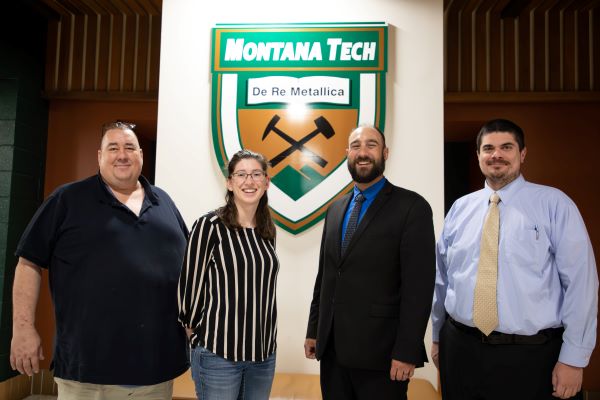Collaborative research with Navy allows Montana Technological University students to expand horizons

Collaborative research between Montana Technological University and the Naval Undersea Warfare Center Division, Keyport officially kicked off this fall, bringing expanded opportunities for talented student researchers to participate in projects for the U.S. Navy.
"The Naval Undersea Warfare Center Division, Keyport team is thrilled about this new Naval Engineering and Education Consortium award to Dr. Lucon and his students. This is exactly the type of research we hoped to accomplish in establishing the Cooperative Research and Development Agreement with Montana Tech last year," said Craig Bleile, a U.S. Navy engineer and scientist. "This grant is turning loose some of the best minds in Montana to solve the navy's challenges while also advancing Montana Tech's education objectives. I look forward to the coming years of combined research and engagement between the university and NUWC Division, Keyport's engineers and scientists."
Bleile visited campus at the beginning of September to celebrate the start of research in Dr. Peter Lucon’s lab.
Dr. Lucon, an associate mechanical engineering professor, who leads the Montana Tech Advanced Materials (MTAM) research group at Montana Tech says, “This and future research through the Naval Engineering Education Consortium will help cultivate the Naval Engineering workforce while building collaboration between Montana Tech and the U.S. Navy. The undergraduate and graduate students performing the research in a multi-disciplinary team across materials engineering, mechanical engineering, computer science, and chemistry will gain competitive experience for their future careers.”
Montana Technological University (MTU) and the Naval Undersea Warfare Center Division, Keyport, entered into a historic cooperative research and development agreement in Fall 2022. The agreement builds from, and leverages, over ten years of research at Montana Tech in materials and manufacturing for defense applications, enabled through the support of U.S. Senator Jon Tester.
Emily Maynard is a first-year graduate student in the Materials Science and Engineering, M.S. program and is a research member of MTAM. Her fully-funded project focuses on improving the 3D printing process. As 3D printing continues to proliferate, engineers still have to work to perfect the process.
“The bonding between the layers isn’t as great as the bonding is between a molded piece,” Maynard notes. “We’re trying to combine a laser with the 3D printer to make it stronger.”
The interdisciplinary project involves testing the strength of the different printed parts. An undergraduate computer science student will take all of the data, and put it into an algorithm, for further analysis of the project’s results.
Maynard is excited by the prospect of working with the Navy because of the vast potential the world’s oceans hold. Engineering in the ocean environment and exploration of its depths are important for many reasons.
“The sea is the most unexplored place in our world,” Maynard said. “We know more about our solar system than what’s in the depths of the sea. We also need more minerals and we don’t have enough minerals in the earth to be able to fuel our needs. The sea might have more of those materials that we need.”
Maynard says she dreamed of being an engineer since the fourth grade. That vision became a reality when she graduated from Montana Tech with a B.S. in Mechanical Engineering in 2021. She worked in industry for two years before pursuing her master’s degree.
“I never thought I would get my master’s degree,” Maynard said. “I am the fourth child out of six and I was the first one to graduate high school, and the only one to graduate college so far. Getting my master’s degree feels like such a big goal.”
As she sets her sight on the future, Maynard is not sure where her future will take her, but she is grateful for the doors that have opened for her through Montana Tech, to go to graduate school and to work with an outstanding organization like the U.S. Navy.
There is no limit to where her career might take her.
“You can do anything you put your mind to,” Maynard said.